

 |
Search the Site with

|
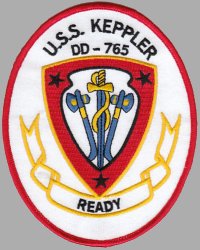 | 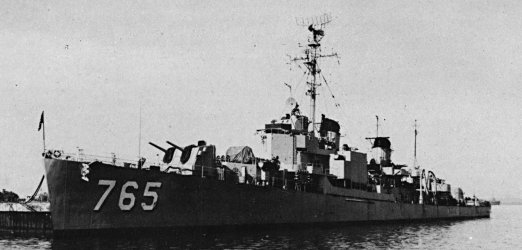 |
USS KEPPLER was one of the GEARING - class destroyers and the first ship in the Navy to bear the name. Two previous ships - DE 311 and DE 375 - were supposed to be named KEPPLER as well, but construction of these vessels was cancelled. Commissioned as DD 765, KEPPLER was reclassified as an Escort Destroyer DDE 765 on March 4, 1950. Reclassified as a Destroyer DD 765 again on June 30, 1962, she served for another ten years before being decommissioned on June 30, 1972. The ship was transferred to the Turkish Navy the same day and was recommissioned as TCG Tinaztepe (D 355). Heavily damaged in a collision with tanker AYGAZ-3 on May 2, 1984, the warship was decommissioned on October 31, 1984, and subsequently sold for scrapping.
| General Characteristics: | Awarded: August 7, 1942 |
| Keel laid: April 23, 1944 | |
| Launched: June 24, 1946 | |
| Commissioned: May 23, 1947 | |
| Decommissioned: June 30, 1972 | |
| Builder: Bethlehem Steel, San Francisco, Calif. | |
| FRAM II Conversion Shipyard: New York Naval Shipyard, Brooklyn, NY | |
| FRAM II Conversion Period: March 1961 - September 1961 | |
| Propulsion system: four boilers, General Electric geared turbines; 60,000 SHP | |
| Propellers: two | |
| Length: 391 feet (119.2 meters) | |
| Beam: 41 feet (12.5 meters) | |
| Draft: 18.7 feet (5.7 meters) | |
| Displacement: approx. 3,400 tons full load | |
| Speed: 34 knots | |
| Aircraft after FRAM II: two DASH drones | |
| Armament after FRAM II: two 5-inch/38 caliber twin mounts, Mk-32 ASW torpedo tubes (two triple mounts), one Hedgehog Mk-15 | |
| Crew after FRAM II: 14 officers, 260 enlisted |
Crew List:
This section contains the names of sailors who served aboard USS KEPPLER. It is no official listing but contains the names of sailors who submitted their information.
USS KEPPLER Cruise Books:
USS KEPPLER History:
KEPPLER was launched 24 June 1946 by Bethlehem Steel Co. Shipbuilding Div., San Francisco, sponsored by Mrs. Elizabeth L. Keppler, widow of John R. Keppler; and commissioned 23 May 1947, Comdr. P. M. Cauiglio in command.
After shakedown along the West Coast, KEPPLER cleared San Diego 9 October 1947 for training exercises in Hawaiian waters. The destroyer then sailed to Australia and China before returning San Diego 20 May 1948. Early in 1949 KEPPLER entered San Francisco Navy Yard for conversion to antisubmarine destroyer. Resuming operations on the West Coast 9 June, she departed San Diego 5 October for duty in the Atlantic.
Arriving Norfolk 15 days later, she immediately commenced intensive ASW exercises along the Atlantic Coast. KEPPLER sailed to Newport, R.I., her new homeport, for additional hunter-killer operations, arriving 27 November. She was reclassified DDE 765 on 4 March 1950 and cleared Newport 5 July for the Mediterranean. Arriving Greece 27 July, the antisubmarine destroyer was ordered to the Far East to help repel Communist aggression in Korea.
After transiting the Suez Canal and crossing the Indian Ocean, KEPPLER joined the 7th Fleet in mid-August. For the next 2 months she patrolled the Formosa Strait before joining PHILIPPINE SEA (CV 47) on 17 November. For the next 3 months she screened her task group during continued carrier air strikes against Communist positions on the Korean mainland. KEPPLER then steamed for Yokosuka, Japan, arriving 7 February 1951. Three days later she cleared port for the United States, reaching Newport 14 March. She was overhauled and for the rest of the year engaged in refresher training and ASW operations.
KEPPLER cleared Newport once again 9 January 1952 to participate in antisubmarine exercises with the 6th Fleet. This cruise culminated in NATO Exercise "Grandslam", in which ships of several nations operated together in practice maneuvers. The antisubmarine destroyer returned to Newport 26 March and resumed operations along the Atlantic Coast.
From 1952 to 1957 KEPPLER continued her vital ASW exercises out of Newport and the Caribbean in addition to NATO operations and Mediterranean cruises with the 6th Fleet.
On 4 January 1957 she sailed toward South American waters for a training and good will cruise. Before returning to Newport 18 March, she visited ports in Colombia, Ecuador, Peru, Chile, and Panama. After completing additional costal exercises, KEPPLER was deployed to the Mediterranean 12 August. During September she transited the Suez Canal to strengthen forces in the Red Sea, as Communists had gained control of the Syrian Army and threatened the pro-western government in Jorden. This display of American determination calmed down the crisis enabling KEPPLER to return to Newport 21 December.
From 1958 to 1961 the antisubmarine destroyer engaged in concentrated ASW operations along the Atlantic coast and Caribbean NATO exercises, a midshipmen cruise in 1959, and a 6th Fleet deployment in the summer of 1960. KEPPLER entered New York Naval Shipyard 1 March 1961 for a FRAM II overhaul designed to increase her service life and effectiveness. Following the overhaul she returned to Newport 25 October and resumed antisubmarine duty 8 March 1962. KEPPLER sailed 4 June for a summer midshipmen cruise to Europe, returning to Newport 30 August. She was reclassified DD 765 during that period.
Two months later a grave international crisis loomed, as the Russians planted offensive missiles in Cuba only 90 miles from the United States. President Kennedy accepted this challenge and ordered a naval quarantine of Cuba. KEPPLER cleared Newport 22 October to take her station in the blockade. While patrolling her Caribbean sector, she sighted a surfaced Russian submarine 2 November and observed it for the next 7 days. On 9 November the submarine joined a Russian trawler, and KEPPLER continued her surveillance until the Russian ships turned back toward the Azores. Effective American sea-power helped persuade the Soviet government to withdraw the missiles easing the crisis. The destroyer returned to Newport 21 November.
During 1963 and 1964 KEPPLER continued hunter-killer exercises along the East Coast and Caribbean. She sailed 8 September 1964 for Mediterranean deployment and engaged in NATO exercises en route. The destroyer returned home 18 December.
Following overhaul in Boston Naval Shipyard, KEPPLER operated out of Newport until sailing for the Far East 4 October 1966. Steaming via the Panama Canal she arrived at Pearl Harbor 24 October and pushed on toward Japan a week later. She departed Yokosuka 14 November for plane guard duty in the Gulf of Tonkin. Early in December she was assigned naval gunfire support missions to assist allied troops fighting in South Vietnam, and she also served in Operation "Sea Dragon" helping to interrupt infiltration of men and weapons into South Vietnam from the North. On the night of 11 and 12 December she rescued a downed pilot.
Early in 1967 she returned to "Yankee Station" for plane guard duty and on 28 January assisted in the rescue of another pilot. In January and February her guns damaged or destroyed 51 Communist junks. KEPPLER's crew derived great "satisfaction from the fact that many of these targets suffered secondary explosions thus proving it was not 'fish' they were carrying." During this period KEPPLER frequently engaged enemy batteries ashore, and on 11 March a Communist gun scored a hit on one of the destroyer's gun mounts. Nevertheless she remained in the fight until returning to Subic Bay on the 23rd. Three days later she headed homeward via the Indian Ocean, the Suez Canal, and the Mediterranean. Upon arriving at Newport 8 May she resumed operations along the East Coast.
KEPPLER received two battle stars for Korean service.
About the Ship's Name:
John Reinhardt Keppler, born in Ralston, Wash., 22 January 1918, enlisted in the Navy 19 February 1936. After an honorable discharge, he reenlisted 25 April 1940 and was assigned to SAN FRANCISCO (CA 38). During the war Boatswain's Mate First Class John R. Keppler participated in action at Pearl Harbor, Bougainville, Salamana, Guadalcanal, and Savo Island. He lost his life in the Savo Island campaign and was awarded the Medal of Honor posthumously. The citation reads:
"For extraordinary heroism and distinguished courage above and beyond the call of duty while serving aboard the SAN FRANCISCO (CA 38) during action against enemy Japanese forces in the Solomon Islands, November 12-13, 1942. When a hostile torpedo plane, during a daylight air raid, crashed on the after machine gun platform, Keppler promptly assisted in removal of the dead and by his capable supervision of the wounded, undoubtedly helped save the lives of several shipmates who otherwise might have perished...Later, although mortally wounded, he labored valiantly in the midst of bursting shells, persistently directing firefighting operations and administering to injured personnel until he finally collapsed from loss of blood. His great personal valor, maintained with disregard of personal safety, was in keeping with the highest traditions of the United States Naval Service. He gallantly gave up his life for his country."
USS KEPPLER Image Gallery:
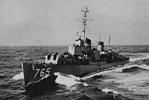 |
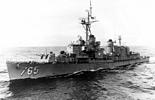 | 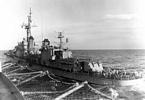 |
 Back to Destroyers list.
Back to Destroyers list.  Back to ships list.
Back to ships list.  Back to selection page.
Back to selection page.  Back to 1st page.
Back to 1st page.